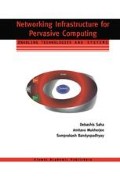Abstract
As discussed in Chapter 2, access in PervNet will preferably be wireless to accommodate end-user mobility. After learning backbone technologies, those will be used in PervNet, in the previous chapter, the focus is now on the wireless access technologies that may find places in PervNet.
Access this chapter
Tax calculation will be finalised at checkout
Purchases are for personal use only
Preview
Unable to display preview. Download preview PDF.
References
S.Ramanathan and M. Steenstrup, “Asurvey of routing techniques for mobile communications networks,” ACM/Baltzer Mobile Networks and Applications, Vol. 1, No. 2, pp. 89–103.
D. Johnson, “Routing in Ad Hoc Networks of Mobile Hosts,” in Proc.IEEE Workshop on Mobile Comp. Systems and Appls. Dec. 1994.
Joseph m. Kahn, and John r. Barry, Wireless Infrared Communications”, Proceedings of the IEEE,pl,pn Vol. 85, no. 2, February 1997.
Walter Hirt, Martin Hassner and Nyles Heise, “IrDA-VFIr (16 Mb/s): Modulation Code and System Design” IEEE Personal Communications,pl,pn Vol. 1, No. 1, February 2001
Peter Barker, Anthony Boucouvalas, “A simulation model of the Advanced Infrared (Air) MAC protocol using OPNET”, Second International Symposium on Communications Systems Networks and Digital Signal Processing, (CSNDSP 2000), 18-20 July 2000, Bournemouth University, UK, pp 153–156
Theodoros Salonidis, Pravin Bhagwat,Leandros Tassiulas, Richard LaMaire, “Proximity Awareness and Ad Hoc Network Establishment in Bluetooth, Technical Research Report CSHCN T.R. 2001-2 http://www.isr.umd.edu/TechReports/CSHCN/2001/CSHCN_TR_2001-1/CSHCN_TR_2001-l.pdf
S. Corson, J. Macker and S. Batsell, “Architectural Considerations for Mobile Mesh Networking”, Internet Draft RFC Version 2, May 1996.
E. M. Royer and C-K Toh, “A Review of Current Routing Protocols for Ad hoc Wireless Networks”, IEEE Personal Communication, pl,pnApril 1999, pp. 46–55.
Z.J. Haas and S. Tabrizi, “On Some Challenges and Design Choices in Ad-Hoc Communications”, IEEE MILCOM’98, Bedford, MA, October 18–21, 1998
G. S. Lauer, “Packet-Radio Routing”, M. E. Steenstrup, editors, Routing in Communications Networks, Prentice-Hall,pn 1995, pp.375–379.
M. Gerla and J. T. Tsai, “Multicluster, Mobile, Multimedia Radio Network,” ACM Wireless Networks, Vol.1, No.3, 1995, pp.255–265.
S.-J. Lee, M. Gerla, and C.-K. Toh, “A Simulation Study of Table-Driven and On-Demand Routing Protocols for Mobile Ad-Hoc Networks,” IEEE Network, vol. 13, no. 4, Jul. 1999, pp. 48–54.
Does the IEEE 802.11 MAC Protocol work well in Multihop Aireless Ad Hoc Networks? S. Xu and T. Saadawi, IEEE Communication Magazine, June 2001, ppl30–137.
S. Bandyopadhyay, K. Hasuike, S. Horisawa, S. Tawara, “An Adaptive MAC Protocol for Wireless Ad Hoc Community Network (WACNet) Using Electronically Steerable Passive Array Radiator Antenna”, GLOBECOM 2001, November, San Antonio, Texas, USA
Poojary, N., Krishnamurthy, S.V. and Dao, S, Medium Access Control in a Network of Ad Hoc Nodes with Heterogeneous Transmit Power Capabilities, Proceedings of ICC 2001,Helisinki.
Shih-Lin Wu and Yu-Chee Tseng, “Intelligent Medium Access for Mobile Ad Hoc Networks with Busy Tones and Power Control” JSAC vol 18 no 9 Sept 2000.
Jeffrey P. Monks, Vaduvur Bharghavan, and Wen-mei Hwu, “A Power Controlled Multiple Access Protocol for Wireless Packet Networks,” IEEE INFOCOM 2001,Anchorage, Alaska, April, 2001.
Bolcskel, H.; Paulraj, A.J.; Hari, K.V.S.; Nabar, R.U.; Lu, Willie W., “Fixed Broadband Wireless Access: State of the Art, Challenges and Future Directions, IEEE Communications Magazine, Volume: 39 Issue: 1 January 2001
Ashok Jhunjhunwala, Devendra Jalihal, K.GiridharWireless in Local Loop — Some Fundamentals, Technical Report, Telecommunications and Networks (TeNeT) Group, Dept. of Electrical Engineering, IIT Madras, Chennai 600 036, INDIA, Dec 2000.
Jay E. Padgett, Christoph G. Günther, and Takeshi Hattori, “Overview of Wireless Personal Communications”, IEEE Communications Magazine • January 1995
Author information
Authors and Affiliations
Rights and permissions
Copyright information
© 2003 Kluwer Academic Publishers
About this chapter
Cite this chapter
Saha, D., Mukherjee, A., Bandyopadhyay, S. (2003). Wireless Access Technology. In: Networking Infrastructure for Pervasive Computing. Springer, Boston, MA. https://doi.org/10.1007/978-1-4615-1143-4_4
Download citation
DOI: https://doi.org/10.1007/978-1-4615-1143-4_4
Publisher Name: Springer, Boston, MA
Print ISBN: 978-1-4020-7249-9
Online ISBN: 978-1-4615-1143-4
eBook Packages: Springer Book Archive

